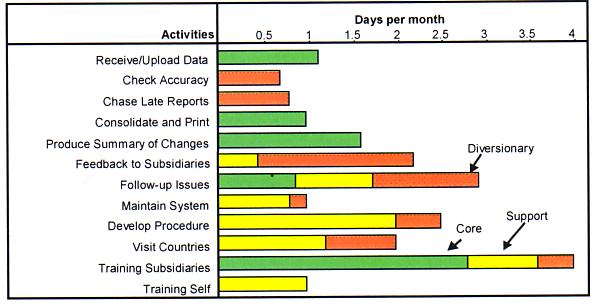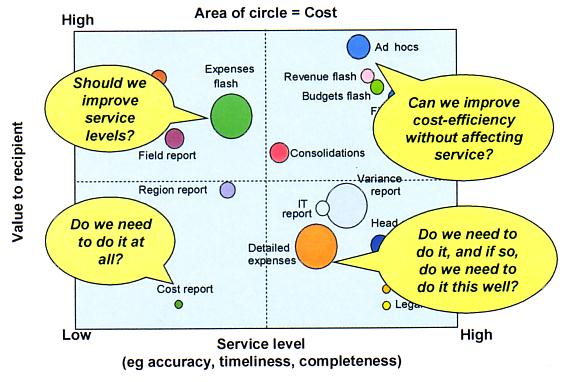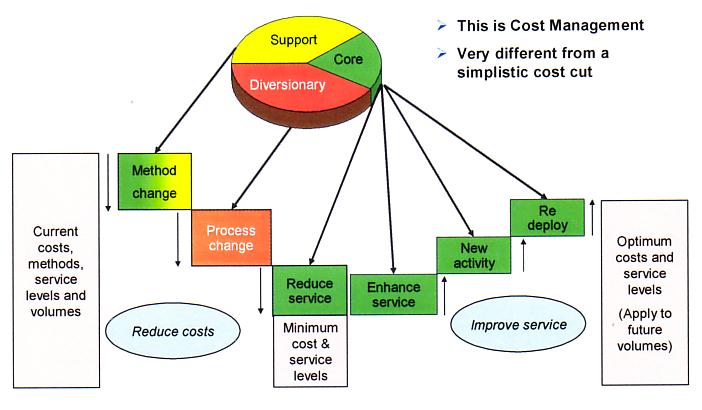
Figure 1.
Organizations under pressure to keep overhead costs low also face demands to increase resources to improve quality and customer service. Typically, a properly conducted Overhead Review will identify cost savings of between 20% and 25% of all controllable overhead costs. While in some areas, costs can be heavily cut; other areas may receive extra resources to meet business imperatives more effectively. As a result, resources are re-balanced.
At one end of the spectrum is radical cost cutting - often urgent resulting from market place changes. At the other end is continuous improvement - the long term pursuit of incremental gains. The approach described here pursues a middle way; one that tackles a very difficult task - reducing costs and improving service levels at the same time!
In most businesses, countless improvements in overhead effectiveness can be identified, but a limited number of specific changes will often suffice to win most of the available benefits. Solutions to the vast majority of business problems can - and should - be identified by the organisation's employees. They know their business best; individually and collectively, they have years of experience.
But the pressures of business life may erode their ability to pool knowledge and share experience. Managers and staff may find themselves working in functional isolation and unable to see the big picture. Unlocking overhead value needs a vehicle to bring people at all levels together in a rigorous process of cross-functional analysis; jointly exploring opportunities for improvement and setting priorities for change.
An Overhead Review should aim to:
Many techniques are used to uncover improvement opportunities, the key ones being:
In any one case, certain techniques will be powerful; others will be less relevant.
A sensible start for an Overhead Review begins with a question - how reliable are the organisation's assumptions about customer service level requirements? Using customer feedback, it ranks the elements of service by criticality in the customers' eyes and assesses how well the organisation meets those requirements in comparison with the competition.
A leading supplier of beverages to the catering industry was assessed by its customers as performing slightly better than competitors in meeting the three most important customer requirements: quality products, competitive price and strong brand. In an aggressive and well-supplied market, this mildly encouraging response by customers was no cause for complacency.
In addition, an investigation into the high scores given to field force helpfulness and effective problem resolution revealed that these items were deemed critically important only because of the problems customers suffered with deliveries and orders. The field force was compensating for serious process failure, and wasting valuable selling time.
The customer feedback highlighted deficiencies in service; it also highlighted opportunities to increase service levels in areas where customers were only moderately satisfied.
Essential to the Overhead Review, therefore, is an understanding of the activities that take place and their alignment with the critical success factors.
We classify overhead activity as either core, support or diversionary.
Core activities add direct value to the business. They are the activities on which the organisation wants its employees to spend most of their time: purchasing, designing, selling, distributing and invoicing.
Support activities do not add direct value, but enable core activities to take place. For example maintaining records or travelling to customers.
Diversionary activities add no value to the business, but arise from a failure somewhere in the organisation: delivery of the wrong goods because a mistake was made in taking the customer's order; manufacturing variances resulting from a hurried product design; checking and correcting work received from another department.
A salesperson's time spent writing proposals and negotiating with a customer is core activity. The time spent travelling to meet the customer is support activity. However, if the meeting is spent sorting out problems caused by late or incomplete deliveries, the activity is diversionary. So is all the subsequent activity, such as product redesign, urgent order processing and special delivery.
Unfortunately, even small errors can cause enormous amounts of diversionary activity. The more complex the business, and the greater the number of departments, the worse the effect. As a result, diversionary activity is usually 20% to 40% of total overhead activity.
Savings in diversionary activities can provide cost savings but some costs should be diverted to other areas to enhance their core which prevents the cause of problems, generally upstream in the process. And if the core activity is generating obvious value to the business then maybe a 50% reduction in diversionary activities could be the equivalent of 100% increase in core with far better return to the business than simply cutting out the costs entirely.
The Global Costing Group of a major international corporation found that the business divisions that it served complained frequently about the high costs of central support, but lacked the information to identify those services they believed to be poor value for money. Its key service was Financial Reporting and the reports were the 'products'. The customers were Regional Management, World Head Office Management, the Financial Consolidation department, Group Treasury department and all the Country Subsidiary companies.
First the Group calculated the direct and indirect cost of the staff involved in the reporting process including salary and employment costs, vehicles, travel and entertainment. Other overhead resources were assigned to people. These costs included rent, power, heating, office furniture and equipment, accounting, training, reception, PCs, e-mail, printers and IT support. This calculation provided a cost per hour for each job grade.
Each member of staff logged how they used their time in a typical month. The categories of activity were identified as shown in figure 1.

Figure 1.
Staff were surprised at the high percentage of diversionary time that was required. Fixing the root causes of this diversionary time provided the opportunity to enhance their service on their core activities.
The activities were then assigned to the outputs from the group. This proved to be very insightful as it exposed which outputs attracted the most diversionary activity. Much of this was due to the need to check and correct errors in the monthly figures provided by the Business Units - an instance of the internal customer creating process failures and then resenting being charged for them!
The divisions were asked to put a measure on the service level they received and the value of that service to them. They were also made aware of the cost of the service. The principle of the analysis is shown in figure 2.

Figure 2.
The valuable outputs were Treasury Reports, Financial and Management Accounts and Advice. The value was made up of content (relevance, actionable), compared to service level (accuracy and timeliness). The costs of producing the outputs could now be compared with the value of the reports as perceived by the internal customers. As a result of this action the Group were able to reduce the frequency or eliminate reports that cost more than they were worth.
Further brainstorming to change methods resulted in the consolidation of the forecast quarterly only at Regional Office, combining treasury actuals with financial submission, distributing checking software to the field and rationalising the Chart of Accounts and entity names.
Six months after implementation the transfers to Head Office reduced from two days to two hours, there was a massive reduction in reporting errors, deadlines were beaten by seven days at month end, and became four days monthly thereafter. The Global Costing Group increased capacity by over 30 per cent and, importantly, stress levels reduced. The high turnover in staff the Group had experienced was eliminated.
Next the overheads review process was implemented across all central overhead departments which led to many services and their costs being changed. The total cost reduction opportunity across all the central services was around 17% of total support costs.
At the heart of the approach are three ways of managing the cost of overhead activities and outputs. By thinking about activities in different ways it makes it far easier to make changes across an organisation in a structured manner, looking at the relative merits of making reductions in some areas and increases in others.
This applies where an activity can be performed at lower cost by changing the method used - for example, through automation, staff training and process simplification or by re-sequencing tasks or moving activity to other parts of the organisation.

Figure 3.
Most diversionary activity is driven by process failure upstream of the function in which it occurs. So the process failure which requires an accounts clerk to raise a customer credit note is likely to have occurred elsewhere, not in the accounts department. When the failures are strung together along a process it is often the case that a simple enhancement at the start of the process can cause a cascade of improvements in every function downstream.
We saw in an earlier section that when considering Value-for-Money, opportunities for service level change require a careful evaluation of risk and benefit to the business, more particularly when service level changes to external customers are being proposed.
The Overhead Review encourages people to think hard about the way they operate and to suggest radically different ways of doing things. How could they manage with significantly reduced resources and yet adequately accomplish the key tasks the business demands of them? What could they avoid doing if others did their jobs better? What important business needs could be met if they had more resources? What improvements to systems and processes would benefit the business?
The outcome is not merely an overall reduction in cost. A shift from diversionary to core activity occurs, as the organisation reduces failures and the number of unnecessary tasks, and concentrates instead on meeting key business and customer needs.
The Overhead Review delivers a significant and rapid reduction in overhead costs - at least 20%, normally identified within a project timescale of 10 to 14 weeks. It achieves a major re-balancing of resources to meet the most pressing needs of the day. In addition, it provides:
